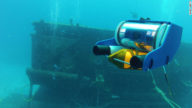
Global Underwater Robotics Market Analysis, Drivers, Restraints, Opportunities, Threats, Trends, Applications, and Growth Forecast to 2027
-
2274
-
May 2023
-
174
-
-
This report was compiled by Correspondence Linkedin | Detailed Market research Methodology Our methodology involves a mix of primary research, including interviews with leading mental health experts, and secondary research from reputable medical journals and databases. View Detailed Methodology Page
-
Global Underwater Robotics Market Overview:
“The global underwater robotics market size is expected to be worth around US$ xx Billion by 2021 from US$ X.xx million in 2031, growing at a CAGR of X.x% during the forecast period 2021 to 2031.”
The report offers in-depth insights, revenue details, and other vital information regarding the global underwater robotics market, and the various trends, drivers, restraints, opportunities, and threats in the target market till 2027.
The report offers insightful and detailed information regarding the various key players operating in the global underwater robotics market, their financials, supply chain trends, technological innovations, key developments, apart from future strategies, acquisitions & mergers, and market footprint.
The global underwater robotics market report has been segmented on the basis of product type, end-user, and region.
Underwater robots are also called autonomous underwater vehicles, and these can be remotely operated. Underwater robots can be beneficial in many aspects such as exploration for oil & gas, mineral exploration, underwater data collection, search and rescue, monitoring sea life and underwater environmental changes, and also in military and defense applications.
Advanced underwater robots can perform high-resolution acoustic, optical, and physical oceanographic surveys in deep oceans that previously were considered impractical or infeasible. The optical link allows the robot to operate in cluttered environments without the need for a tether.
Technological advancements in sensors used in underwater robots, vast application in various industrial sectors, and rising demand for underwater robots in defense are key factors driving the growth of the global underwater robotics market.
In addition, increasing research and development activities, and growing awareness about the availability of advanced imaging systems that can be used in low depths are other factors expected to fuel the growth of the global underwater robotics market over the forecast period.
However, the high cost of R&D for the development of underwater robots is a key factor restraining the growth of the global underwater robotics market. Additionally, malfunctions that may occur while performing underwater expeditions or surveys are another factor anticipated to hamper the growth of the global underwater robotics market over the forecast period.
The market in North America is anticipated to account for the highest revenue share in the global underwater robotics market, followed by the market in the Asia Pacific. This can be attributed to the increasing use of underwater robots in the defense sector in countries in the region.
The market in the Asia Pacific accounted for the second-highest revenue share in the global underwater robotics market, owing to the high adoption of underwater robots in emerging economies in the region. Also, the underwater robotics market in Europe is also expected to witness significant growth over the forecast period.
Global Underwater Robotics Market Segmentation:
Global underwater robotics market segmentation by product type:
- Cable remote control type
- No cable remote control type
Global underwater robotics market segmentation by end-user:
- Scientific Exploration
- Military
- Underwater Construction
Global underwater robotics market segmentation by region:
- North America
- Europe
- Asia Pacific
- Latin America
- Middle East & Africa
Attribute Report Details Market Size Ask For Market Size Growth Rate Ask For Growth Rate Key Companies Ask For Companies Report Coverage Revenue analysis, Competitive landscape, Key company analysis, Market Trends, Key segments, Distribution Channel, Market Dynamics, COVID-19 Impact Analysis and more… Historical Data Period 2015-2020 Base Year 2022 Forecast Period 2022-2031 Region Scope North America, Europe, Asia-Pacific, South America, Middle East & Africa Country Scope United States, Canada and Mexico, Germany, France, UK, Russia and Italy, China, Japan, Korea, India and Southeast Asia, Brazil, Argentina, Colombia etc.Saudi Arabia, UAE, Egypt, Nigeria and South Africa Revenue in US$ Mn -
-
- Deep Ocean Engineering, Inc
- General Dynamics Mission Systems, Inc.
- ECA Group
- International Submarine Engineering Limited
- Soil Machine Dynamics Ltd.
- Inuktun Services Ltd
- MacArtney A/S
- Atlas Maridan
- Phoenix International
- Schilling Robotics




